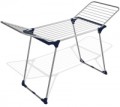Legs
The shape of the
legs plays a crucial role in both the aesthetic and practical aspects of floor dryers.
—
U-shaped. Floor dryers featuring two U-shaped legs provide stability during use and reduce the risk of tipping. These legs are typically positioned at slight angles to the floor, often with a plastic lining on the lower crossbar. U-shaped legs offer the convenience of easy vacuuming underneath the dryer or placing objects under it.
—
X-shaped. Many floor clothes dryers feature legs arranged in a crosswise manner. These legs unfold together in a single motion, simplifying the setup process. When folded, the X-shaped legs neatly align with the dryer's main body, where the drying bars are situated. The design prevents any obstruction from the sides.
—
A-shaped. Dryers with A-shaped legs use support points formed by crossbars resembling the letter "A." These legs extend from a central upper point within the dryer's working area and are positioned at slight angles to each other. To enhance stability, they are frequently connected by a jumper. A-shaped legs often function as a miniature version of a fulcrum.
Total working surface
Under the total working surface is meant the total length of all drying rods in the expanded state. The
longer this length, the more laundry can be placed on the dryer and, usually, its maximum load is higher (see below). At the same time, this parameter also affects the dimensions and price of the device.
Number of rods
The number of individual rods provided for in the design of the drying rack. The more such rods are provided for with the same total working surface, the shorter the length of each of them and the more compact the dimensions of the device in the unfolded state can be. On the other hand, short rods are poorly suited for sheets, blankets and other large items.
Number of tiers
The number of tiers — a kind of "floors" — on which the drying rods are located. This parameter in our catalog is indicated only if there are more than one tiers. At the same time, street-type models (see above), which have a structure similar to an inverted umbrella, are not considered multi-tiered, since the rods are placed at different heights from the ground in them, but not by “floors”.
The presence of several tiers allows you to place more laundry on the drying rack with the same occupied area, however, the weight and price of the structure also increase accordingly. In addition, note that the distance between the tiers may not be sufficient for long items (for example, towels).
Side wings
The side wings are additional folding shelves, provided mainly in floor models (see "Type") and installed at the ends. Such shelves allow, if necessary, to increase the usable area, and when not in use, they usually fit directly on the main work surface and do not take up extra space in the surrounding space.
Hanger holder
The presence in the design of the drying rack of special devices for the placement of coat hangers. Such devices can be made as separate stands, and in
outdoor models(see "Type") they often have the form of openings at the ends of rigid rods that form the frame.
Technically, most drying racks allow you to use regular rods to place hangers, however, special
holders for hangers are much more convenient: in particular, when using them, the hanger will not move (whereas it can move back and forth along the rod), and there will still be a place on the main surface completely free.
Material
The main material from which the dryer is made.
— Aluminium. These models, crafted from lightweight and usually affordable aluminium alloys, come with both low weight and cost. However, compared to steel, inexpensive aluminium alloys typically lag behind in terms of strength and durability. Additionally, continuous exposure to water may cause oxidation, resulting in potential stains. While high-quality alternatives address these issues, they come with a corresponding increase in cost.
— Steel. Modern dryers typically utilize two main types of steel: regular and stainless. Ordinary steel boasts good strength at a low cost, although it is heavier than aluminium, which is not a critical factor. However, ordinary steel is prone to rust when exposed to moisture, necessitating protective coatings that can compromise the product's reliability and durability. On the other hand, stainless steel shares the same advantages but is corrosion-resistant and offers long-term use. Its main drawback is the higher price.
— Aluminium/steel. Two design types fit into this category. The first involves combined products, where the stand and main frame are typically crafted from steel, while the bars are made of aluminium. As detailed above, both materials have their characteristics, and combining them slightly boosts the strength and reliability of the dryer while keeping costs low. Additionally, models are available in various materials, including "aluminium.../steel."
— Plastic. The main advantage of plastic as a material for dryers is complete chemical inertness — in other words, it does not oxidize from constant contact with moisture. At the same time, in terms of strength, plastic significantly loses to metals. Therefore, this option is used mainly in small-sized designs that are not designed for a large amount of laundry.
Dimensions (unfolded)
General dimensions of the drying rack in working position, taking into account all additional elements — side wings (see above), retractable parts (see "Design"), etc. This parameter will allow you to estimate how much space is required to use a particular model.
Dimensions (folded)
General dimensions of drying rack in the folded position. The smaller they are, the more convenient this model is in storage and transportation.

